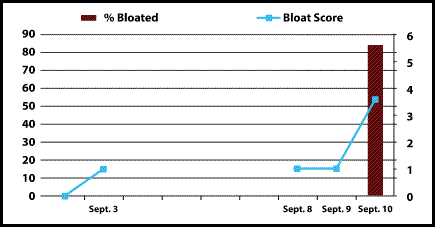
Bloat Hazard:
Grazing Alfalfa In Fall 2010
After Labor Day weekend, many Montana ranchers begin sizing up their hay crop and pastures for fall and winter feed. Across Montana, substantial rain during 2010 has resulted in a supply of stored hay and standing grass — best described as “bodacious.” In many counties of central and eastern Montana, the growing season precipitation (April 1 through Sept. 1) matched or exceeded the long-term average annual precipitation.
Alfalfa and alfalfa-grass hayfields are widely utilized as a “hay-stockpile” system in Montana and the northern Great Plains. Alfalfa aftermath in late summer and autumn is a high-quality pasture for preconditioning calves, putting body condition on bred cows and flushing ewes. Alfalfa regrowth is a rich source of protein, energy, vitamins and minerals. However, due to the potential for pasture bloat, ranchers should always be cautious when grazing alfalfa-dominated hayfields. Fall grazing presents some specific challenges, particularly in 2010.
What is pasture bloat? Ruminant livestock grazing lush pastures of alfalfa, clovers and small grains are prone to a condition called “frothy bloat.” Rapid digestion of forage containing highly soluble proteins results in a stable foam that prevents rumen gases from being expelled by normal eructation (belching). Individual animals or a herd can experience severe symptoms, including rapid death. The bloat hazard of alfalfa generally increases with lush, vegetative growth, during cool weather (spring or fall frosts), rain, with high soil fertility, but can occur any time during the summer. For season-long grazing, the rumen microflora can adjust such that an animal becomes bloat-tolerant. Alfalfa-based pastures are very productive for grazing yearlings. However, rapid changes in diet quality (such as moving cows from dry grass to lush alfalfa) are risky. Aside from bloat-inducing crops, bloat is a complex response in terms of pre-existing health conditions and mineral status of livestock. A good description of bloat and its prevention are in the Cattle Producer’s Library (www.csubeef.com/dmdocuments/625.pdf ).
Why is alfalfa grazing in the fall risky? It appears that many of our livestock feeding issues in the autumn and winter are directly related to vast changes in diet quality and the environment during gestation. For example, bloat on alfalfa pasture, nitrate toxicity of cereal hay, and many illnesses or mineral imbalances occur as a result of quick shifts in forage quality and quantity. A particularly risky time for grazing alfalfa is immediately following frost. From 1998 through 2000, we conducted grazing experiments with cattle and sheep on pure stands of alfalfa. Grazing occurred in 10 trials from late spring through late summer. Bloat was evaluated by incidence (% of animals with symptoms) and a subjective severity score (1 = no symptoms; 6 = dead) of bloat assigned multiple times during the day. Due to paddock sizes and animal numbers (24 to 40 ewes), the data from sheep grazing were the most useful. Across all three years, grazing incidence was most severe in late spring and late summer, but occasional bloat “storms” occurred in mid-summer.
In 1999, we monitored bloat over several days in which the weather forecast predicted first frost (<32° F). On Sept. 3, 8, 9 and 10 the overnight minimum temperatures were 34°, 36°, 33° and 26° F, respectively. Sept. 10 was one of the worst bloat days during the study, with over 80% of the ewes bloated (average severity score = 3.6, Fig. 1). Immediately following a “hard” freeze (defined as adequately cold to rupture cell walls) concentrations of soluble proteins and sugars are very high in the alfalfa forage, which increases its risk for bloat. In general, the forage becomes safer to graze after the stems have collapsed and dried for several days after freezing.

In 2010, many producers avoided taking second or third harvests of alfalfa hayfields due to bountiful hay supplies and low prices. Delayed first-cut alfalfa and cool, wet conditions have resulted in a large supply of lush alfalfa regrowth for fall pasture. In short, these conditions are fairly risky for alfalfa bloat this year.
How do I prevent or control bloat? Several legume species such as sainfoin, cicer milkvetch and bird’s-foot trefoil do not cause bloat, so consider these when renovating pastures. A number of products are promoted as “bloat preventative,” including specific alfalfa varieties, ionophores and mineral mixes. However, the most studied and effective treatment is poloxalene (Bloat Guard) — combined with good animal health practices such as mineral supplementation and vaccinations. The alfalfa should be flowering. Livestock should be fed dry roughage before turning out on alfalfa pasture. The pasture should be dry, and grazing should be continuous rather than frequent corralling or movement. Paddock rotation should occur in the afternoon. The animals should be monitored multiple times daily initially, and daily thereafter. The intake of poloxalene should be monitored, as intake will vary among animals and days.
In summary, the value of alfalfa pasture in the fall is very high if the risk of pasture bloat can be controlled.
Fig. 1: Incidence and severity of bloat of 24 mixed purebred ewes following hard freeze in Sept. 1999 near Bozeman, Mont. (MacDonald, C.M. 2001, M.S. Thesis, Montana State University).





